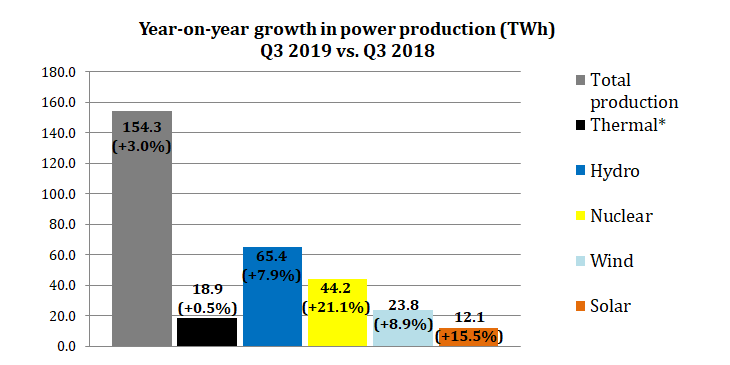And some informed commentary as well.
From the U.S. Energy Information Administration:
In the News:
Futures prices signal cheaper mid-winter natural gas in most regions in 2020
The current outlook for natural gas prices at key hubs reflects market expectations for lower prices in mid-winter (January and February), except in New England. Two factors account for generally lower prices: lower natural gas futures prices at the Henry Hub and lower regional differentials to the Henry Hub (the basis). The Henry Hub price is lower because of higher-than-average natural gas storage inventories and strong production. Regional prices at many key trading hubs have lower premiums to the Henry Hub price because natural gas pipeline constraints have eased.The futures are trading down a bit from where they were when we posted "EIA Natural Gas Storage Report: Time for a Short" this morning, 2.635 last.
Average, forward natural gas prices for January and February 2020 at key regional natural gas trading hubs—Algonquin Citygate, Henry Hub, Chicago Citygate, Southern California Gas Citygate (SoCal Citygate), and Sumas—currently reflect lower overall prices compared with this time a year ago. Except at Henry Hub, these forward prices are a combination of the Henry Hub futures contract and the basis futures contract (the regional component of the overall price).
Algonquin Citygate – The Algonquin Citygate price is a good proxy for the wholesale price of natural gas delivered to New England. The Algonquin price is typically at a premium to the Henry Hub price throughout mid-winter because of constraints on key natural gas pipelines. The premium to Henry Hub this mid-winter is expected to average $6.07 per million British thermal units (MMBtu). The average January and February 2020 natural gas futures prices in New England is 11¢ higher than last year despite the lower Henry Hub futures price for those months. This higher price differential is the result of expectations for high utilization on natural gas pipelines such as Algonquin Gas Transmission and Tennessee Gas Pipeline. Average spot prices month-to-date in October averaged $1.75/MMBtu, 47¢ lower than Henry Hub.
SoCal Citygate – Forward markets indicate a narrowing basis price for Southern California. The average SoCal mid-winter price this year is $1.33/MMBtu higher than the Henry Hub price compared with last year’s mid-winter price difference of $3.32/MMBtu higher than Henry Hub.
Key factors contributing to lower SoCal Citygate mid-winter prices include;
During the past few winters, Aliso Canyon was only available for withdrawals as a last resort. Average spot prices month-to-date in October averaged $3.56/MMBtu, $1.34 higher than Henry Hub.
- Increased overall pipeline capacity associated with repairs to Southern California Gas Company’s (SoCalGas) Line 235-2
- The return of 270 million cubic feet per day of capacity at Topock and Needles (supporting access to lower cost natural gas supplies in the San Juan and Permian Basins)
- The California Public Utilities Commission granting SoCalGas more flexibility this winter to withdraw from the Aliso Canyon natural gas storage facility
Sumas – The basis price has narrowed as the region recovers from an October 2018 pipeline explosion in British Columbia, which elevated natural gas prices in the Pacific Northwest. The average mid-winter basis price this year at Sumas is $0.73/MMBtu higher than the Henry Hub price compared with last year’s mid-winter price difference of $1.93/MMBtu. According to Genscape, average October flows through Sumas in 2019 have increased 22% compared with average flows last October, but they are still down 27% compared with average flows in October 2017. However, Natural Gas Intelligence reports that Westcoast Transmission updated its maintenance calendar, which shows that flows through Sumas are set to return to near normal capacity in November. Average spot prices month-to-date in October averaged $3.41/MMBtu, $1.19/MMBtu higher than the Henry Hub price.
Chicago Citygate – According to forward markets, the narrow basis price that occurred in mid-winter 2019 should further shrink in mid-winter 2020. In mid-winter 2019, the basis was $0.68/MMBtu The mid-winter 2020 basis has shrunk to just $0.38/MMBtu as higher volumes of low-cost natural gas from the Appalachia Basin are expected to continue flowing into the Midwest. Average spot prices month-to-date in October averaged $1.97/MMBtu, 25¢/MMBtu lower than the Henry Hub price.
Overview:
(For the week ending Wednesday, October 30, 2019)
- Natural gas spot prices rose at most locations this report week (Wednesday, October 23 to Wednesday, October 30). Henry Hub spot prices rose from $2.28 per million British thermal units (MMBtu) last Wednesday to $2.67/MMBtu yesterday.
- At the New York Mercantile Exchange (Nymex), the November 2019 contract expired Tuesday at $2.597/MMBtu, up 32¢/MMBtu from last Wednesday. The December 2019 contract increased to $2.691/MMBtu, up 26¢/MMBtu from last Wednesday to yesterday. The price of the 12-month strip averaging December 2019 through November 2020 futures contracts climbed 14¢/MMBtu to $2.498/MMBtu.
- Net injections to working gas totaled 89 billion cubic feet (Bcf) for the week ending October 25. Working natural gas stocks are 3,695 Bcf, which is 18% more than the year-ago level and 1% more than the five-year (2014–18) average for this week.
- The natural gas plant liquids composite price at Mont Belvieu, Texas, rose by 2¢/MMBtu, averaging $5.27/MMBtu for the week ending October 30. The price of isobutane and butane fell by 7% and 1%, respectively. The price of natural gasoline, ethane, and propane rose by 3%, 2%, and 1%, respectively.
- According to Baker Hughes, for the week ending Tuesday, October 22, the natural gas rig count decreased by 4 to 133. The number of oil-directed rigs fell by 17 to 696. The total rig count decreased by 21, and it now stands at 830.
Prices/Supply/Demand: Prices rise at most locations with the onset of cold weather. This report week (Wednesday, October 23 to Wednesday, October 30), the Henry Hub spot price rose 39¢ from $2.28/MMBtu last Wednesday to a high of $2.67/MMBtu yesterday. Temperatures were cooler than normal across most of the country and warmer than normal on the eastern seaboard. At the Chicago Citygate, the price increased 40¢ from $2.29/MMBtu last Wednesday to a high of $2.69/MMBtu yesterday.....MUCH MORE









